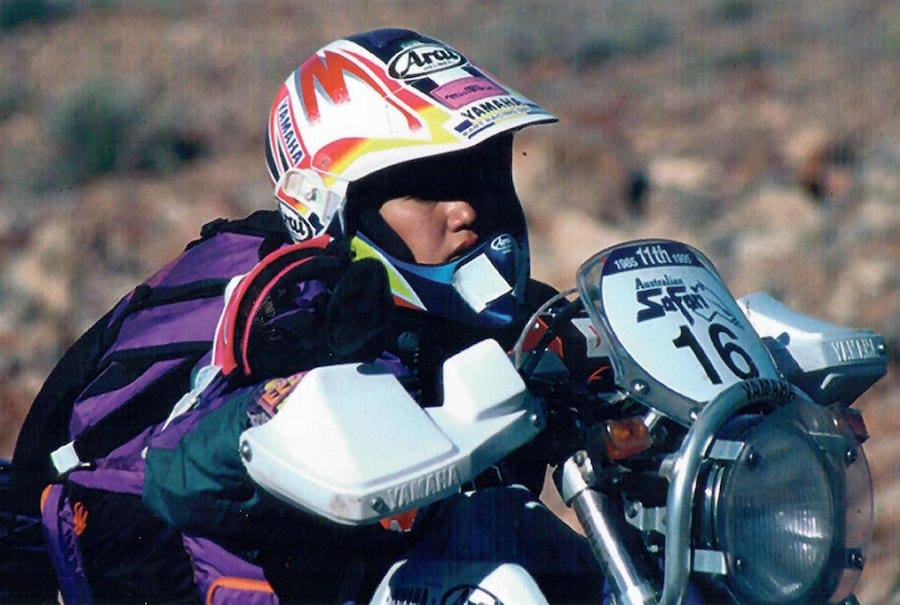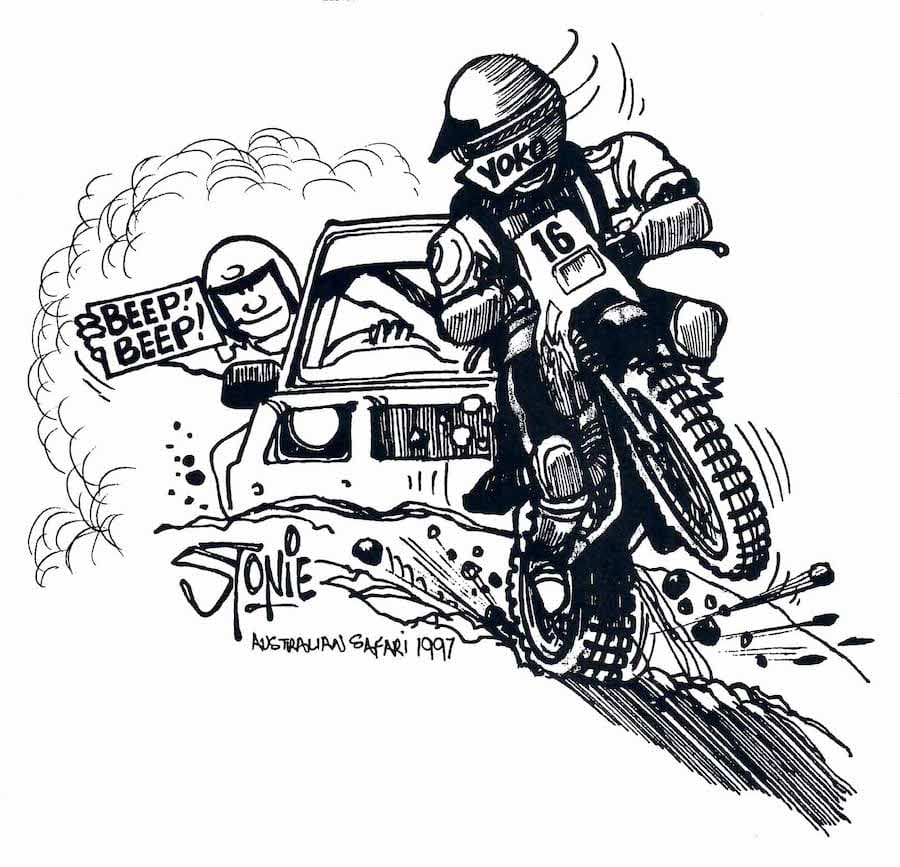By 1990, the Australian Safari had become the most notorious motorsport broadcast on Japanese TV, with millions of viewers in their tiny city abodes enthralled by a phalanx of vehicles tearing across Australia’s endless landscape. Safari naming rights were snapped up by large Japanese conglomerates such as Computerland whose influence permeated the event; even more so when Kenjiro Shinozuka won the Auto Division. This resulted in scores of Japanese riders heading Down Under on the chance they could achieve Samurai status in their homeland.
As early as 1987 Japanese riders had contested the ‘Sydney to Darwin’; Hideaki Suzuki being remembered for his kamikaze riding style and his enthusiasm. Whenever greeted with a smile, Hideaki would clench his first toward the sky and shout “DARWEEN”. He made it; though his three countrymen became known as Day One, Day Two and Day Three with respect to their DNFs. Forty two hopefuls entered in 1990, few with any competition experience at all; and even Yoshifumi Sugio – a recognised road racer – found his experience to be of little help crossing the Sturt Stony Desert.
Certainly the involvement of the Japanese enhanced the status of the Safari and created numerous accounts of riders who, almost too exhausted to stand, would never give up their quest as long as they drew breath. Despite a horrendous attrition rate, the would-be Bushido warriors kept arriving for the great Outback adventure hoping to earn a highly coveted Finishers Medallion. They quickly learnt big-bore machines were too heavy to handle but, despite their lack of Outback experience, some such as Yuji Uemura, Youchiro Shige and Hasao Yashimoto achieved podiums in the small-capacity classes.
Hideaka Nakajima was one of the few to face the test on more than one occasion but most came once and never returned. However on return to their home country as heroes, they all proved that it’s better to have a go and fail, than fail to have a go.
Yoko Fukagawa was undoubtedly one rider who demonstrated the tenacity and commitment to succeed. Following a DNF in the 1994 Sydney to Darwin Safari, Yoko returned the following year for the first Adelaide to Townsville event; determined to earn a Finishers Medallion. Not only did Yoko have to overcome the same difficulties as the other competitors, she was totally deaf, having to determine her Yamaha TT250’s engine performance simply by feel.

At the conclusion of Day Six in Cloncurry, Yoko was just about done in. However her competitors, somewhat awed that she had made it that far, encouraged her to persevere; particularly as the following morning included little more than a lengthy liaison on the bitumen down to Julia Creek.
Unfortunately Yoko’s mechanic had failed to tighten the sump plug after changing the oil and, unable to detect any sound of an engine starving for oil until the final death rattle, Yoko’s Safari was over.
Yet two years later she was back again and this time received her Finishers Medallion in the longest Safari of all; the 15-day odyssey from Cairns to Uluru then back to the Gold Coast. And, just to prove that it could be done, Yoko returned in 2000 for a class victory in the Auto Division.
From a peak in 1994, entrants from the Land of the Rising Sun dwindled, though when the Safari was reborn in Western Australia in 2007, the unlikely duo of Huey Yada and Mamezoh Fukuhara entered the Pairs Division. They’d flown into Perth and picked up a new Honda CRF450X on a buy-back deal, bolted on a Tupperware container for a map roller and occy-strapped a five-litre jerry on the back. They also outlaid $1000 for an ageing Ford Telstar which they drove to Darwin – to pick up a couple of mates to act as service crew – then drove 1600km back to Kununurra for the start. The pair finished in 56th position; but they finished.
By Peter Whitaker












